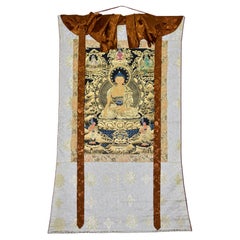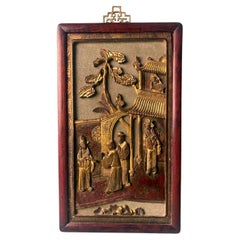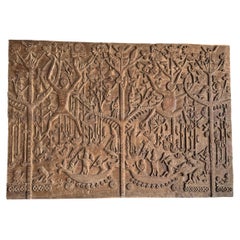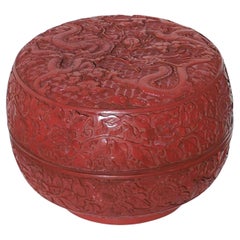Asian Art and Furniture
Early 1900s Tibetan Antique Asian Art and Furniture
Copper, Silver
2010s Nepalese Tibetan Asian Art and Furniture
Brocade, Wood, Paint
Late 19th Century Chinese Chinoiserie Antique Asian Art and Furniture
Wood
Mid-19th Century Chinese Qing Antique Asian Art and Furniture
Linen, Silk
21st Century and Contemporary Indonesian Organic Modern Asian Art and Furniture
Teak
Early 20th Century Chinese Qing Asian Art and Furniture
Lacquer
19th Century Antique Asian Art and Furniture
Wood
Early 20th Century Japanese Asian Art and Furniture
Bronze
Early 20th Century Chinese Qing Asian Art and Furniture
Milk Glass
19th Century Japanese Meiji Antique Asian Art and Furniture
Gold Leaf
20th Century Japanese Showa Asian Art and Furniture
Silk, Plexiglass, Paper, Wood
Early 20th Century Chinese Qing Asian Art and Furniture
Wood
20th Century Southeast Asian Tribal Asian Art and Furniture
Bronze
19th Century Indian Antique Asian Art and Furniture
Silver
Late 19th Century Japanese Meiji Antique Asian Art and Furniture
Metal, Enamel
1920s Chinese Ming Vintage Asian Art and Furniture
Wood
Early 19th Century Japanese Edo Antique Asian Art and Furniture
Shell, Brocade, Silk, Glass, Wood, Paint, Paper
Late 18th Century Thai Other Antique Asian Art and Furniture
Metal
Early 20th Century Chinese Asian Art and Furniture
Stone
20th Century Japanese Other Asian Art and Furniture
Stone
Early 20th Century Japanese Asian Art and Furniture
Paper
Late 20th Century Chinese Qing Asian Art and Furniture
Milk Glass
Late 19th Century Antique Asian Art and Furniture
Brass
Early 20th Century Unknown Chinese Export Asian Art and Furniture
Bronze
Mid-20th Century Japanese Mid-Century Modern Asian Art and Furniture
Brass, Enamel
20th Century Turkish Moorish Asian Art and Furniture
Silver Plate
Mid-19th Century Chinese Qing Antique Asian Art and Furniture
Elm
20th Century Persian Sarouk Farahan Asian Art and Furniture
Wool
15th Century and Earlier Cambodian Antique Asian Art and Furniture
Bronze
Late 19th Century Chinese Ming Antique Asian Art and Furniture
Rattan, Fruitwood
1920s Chinese Qing Vintage Asian Art and Furniture
Ceramic
1850s Chinese Qing Antique Asian Art and Furniture
Jade
Mid-20th Century Canadian Native American Asian Art and Furniture
Soapstone
1860s Japanese Meiji Antique Asian Art and Furniture
Softwood, Lacquer
19th Century Japanese Meiji Antique Asian Art and Furniture
Silver Leaf
19th Century Chinese Qing Antique Asian Art and Furniture
Porcelain
1930s Chinese Art Deco Vintage Asian Art and Furniture
Marble
Early 20th Century Chinese Chinese Export Asian Art and Furniture
Porcelain
20th Century Chinese Chinese Chippendale Asian Art and Furniture
Brass
1960s Japanese Mid-Century Modern Vintage Asian Art and Furniture
Paper
Early 20th Century Asian Asian Art and Furniture
Stone, Bronze
19th Century Vietnamese Antique Asian Art and Furniture
Ceramic
15th Century and Earlier Persian Archaistic Antique Asian Art and Furniture
Iron
15th Century and Earlier Israeli Antique Asian Art and Furniture
Sandstone
19th Century Japanese Meiji Antique Asian Art and Furniture
Porcelain
Early 20th Century Chinese Chinese Export Asian Art and Furniture
Wood
Early 20th Century Tibetan Tibetan Asian Art and Furniture
Ceramic
Early 20th Century Chinese Ming Asian Art and Furniture
Wood
Late 19th Century Japanese Antique Asian Art and Furniture
Ceramic, Porcelain
Early 20th Century Japanese Japonisme Asian Art and Furniture
Textile, Acrylic
20th Century Chinese Qing Asian Art and Furniture
Cut Glass
Early 19th Century Chinese Chinese Export Antique Asian Art and Furniture
Porcelain
Late 20th Century American Modern Asian Art and Furniture
Ceramic
20th Century Chinese Asian Art and Furniture
Porcelain
Early 20th Century Japanese Meiji Asian Art and Furniture
Bronze
19th Century Chinese Meiji Antique Asian Art and Furniture
Bronze
17th Century Hong Kong Qing Antique Asian Art and Furniture
Ceramic
19th Century Japanese Antique Asian Art and Furniture
Wood
Early 20th Century Chinese Chinese Export Asian Art and Furniture
Jade, Bronze
Mid-20th Century Chinese Asian Art and Furniture
Ceramic
Antique and Vintage Asian Art and Furniture
From Japanese handmade earthenware pottery, originating circa 14,500 B.C. and adorned with elaborate corded patterns known as jōmon, to natural elm case pieces and storage cabinets built in Qing dynasty–era China to mid-century Thai rice-paper charcoal rubbings, antique and vintage Asian art and furniture make for wonderful additions to all kinds of contemporary interiors.
Eastern elements elevate any home’s decor. Introduce zen sensibility to your living room, dining room and bedroom with the neutral color palettes and the natural materials such as rattan, bamboo and elm that we typically associate with traditional Asian furniture. Decorative handwoven embroideries and textiles originating from India and elsewhere on the continent, which can be draped over a bed or sofa or used as a wall hanging, can be as practical as they are functional, just as you wouldn’t seek out Japanese room-divider screens — often decorated with paintings but constructed to be lightweight and mobile — merely for privacy.
With everything from blanket chests to lighting fixtures to sculptures and carvings, it’s easy to tastefully bring serenity to your living space by looking to the treasures for which the East has long been known.
For British-born furniture designer Andrianna Shamaris, the Japanese concept of beauty in imperfection isn’t limited to her Wabi Sabi collection. She embraces it in her New York City apartment as well. In the living area, for instance, she retained the fireplace’s original black marble while swathing its frame and the rest of the room in bright white.
“We left the fireplace very clean and wabi-sabi, so that it blended into the wall,” says Shamaris, who further appointed the space with a hand-carved antique daybed whose plush pillows are upholstered in antique textiles from the Indonesian island of Sumba.
In the growing antique and vintage Asian art and furniture collection on 1stDibs, find ceramics from China, antiquities from Cambodia and a vast range of tables, seating, dining chairs and other items from Japan, India and other countries.
Read More
Symbols of Happiness and Rebirth Adorn This Japanese Satsuma Bowl
Decorated with white cranes and the sought-after thousand-butterflies motif, the Meiji-period vessel offers both a celebration of traditional aesthetics and a clear reflection of the era’s appetite for exquisite export pieces.
Chicago’s Pagoda Red Has a Spirited Mix of Asian Antiques and Bold New Art
For 25 years, gallerist Betsy Nathan has leveraged her keen eye and key connections to bring a unique selection of rare finds to the market.
In L.A., Gallerist JF Chen Has Long Championed Eclectic Blue-Chip Design
Now working alongside his daughter Bianca, dealer Joel Chen has presented a most covetable array of antiques, art and contemporary creations for more than 40 years.
12 Calming Spaces Inspired by Japanese Design
From cherry-blossom-adorned walls paired with glamorous lighting to wood-paneled ceilings above checkerboard-patterned chairs, these 12 spaces seamlessly blend Eastern and Western aesthetics.
Rodrigo Rivero Lake’s Mexico City Showroom Is a Museum-Worthy Trove of Spanish Colonial and Asian Antiques
The dealer and curator has spent the past 50 years amassing a collection of exceptional art, furniture and architectural elements that trace the cultural influence of the Spanish empire from Europe to the Americas and beyond.
16 Refined Asian-Inspired Interiors
These spaces exemplify how Eastern elements elevate a home's decor.





